«previous pageCOMMUNITY SERVICE CATEGORY
Dead Tires on the Sidewalk, Dead Tired at the Bus Stop
Andrew Kanzler, Student ASLA
California State Polytechnic University, Pomona, CA
faculty advisors: Chris Aykanian, Claire Latane, ASLA, and Andy Wilcox, ASLA
Project Statement
Bus patrons must stand or steal crates to be used as makeshift seats while waiting for the bus. A utilitarian, sculptural, and regenerative system is developed based on the byproducts of the local economy to provide dynamic seating and allow bus patrons to take back and claim ownership of unused public space.
Project Narrative
In a city such as Pomona with over 21% of the population under poverty and an average income of $40,000 there are not many resources for the people of the city to build upon. The numbers of jobs in Pomona are just under 58,000 with a population of 149,473. With the economy of Pomona heavily dependent on services such as automotive and tire services, the culture of Pomona is duly affected.
The culture of Pomona is affected by the presence of a historic district, an artist's colony, and poverty. The resulting program for the bus stop grows from the culture of Pomona. The program is not implanted into Pomona but it rather generates itself from the people and the byproducts of the community. The artistic value of the chairs are grown out of the artist's colony not on a level of high brow sophistication but rather as outside of the marketplace and as found objects that can be reorganized and reutilized.
These pieces are utilitarian designs reorganizing the arbitrary signifiers of what a chair is. The symbol for a chair is most often a platform atop four legs with a back. Even a Bus stop bench contains four legs and a back and by sight it is known to be a signifier for sitting. When these chairs are placed they will not be understood as chairs until they are utilized as chairs. They are only immediately seen as sculptural elements that draw curiosity. The signifiers go beyond chair; with the economy of Pomona permeating through its culture it is only appropriate to reorganize tires as something new. It is the aesthetic and semiotic nature of poverty.
These chairs are not just reorganized symbols but they are also reorganized structural object. The circle is the most structurally sound object. Like arches on a bridge the circle distributes weight and is then able to hold more weight. A double helix combines a circle adding a third dimension with two circles. The shape of the chairs is not just a double helix but with the reattached ends, it becomes a sphere. The ergonomics of sitting on a sphere helps improve posture and reduce fatigue. It aligns the back and allows for people to rock back and forth.
The mobility of the chairs is a nuance of the nature of tires themselves. Tires are meant to travel and these chairs are also meant to travel. With this particular bus stop, the chairs can be moved in and out of shade provided by trees, closer to the bus stop to get a better view and even next to each other so that people can sit with their families. Children have also discovered the mobility and usability of the chairs as part of their play. One passerby said "I saw two kids playing on them, they looked pretty damn happy."
Seats for bus stops are often placed on the sidewalk directly in the face of traffic. This particular bus stop along with many others are adjacent to privately owned public open spaces. These spaces are usually parts of parking lots or embellishments of buildings and businesses. By allowing for seating and mobility, users can take back unused space turning it into a public bus stop with all the comforts of a public park.
Beyond aesthetics and structural integrity is the regenerative and sustainable quality of the items. These objects are reorganized from trash into something entirely different and useful. The amount of tire waste in the country exceeds the population of the country. And the energy it takes to recycle tires is not an environmentally friendly amount. The direct reuse of tires with very little nuances can be generated by the people and for people from what would once be considered waste but would now be considered a resource. They can be generated by the people very easily as the design takes into consideration ease of construction. The sculptural quality will also encourage users to ride the bus rather than drive reducing the amount of carbon put into the air. It will not only convert waste into a resource but by developing cultural signifiers of the community of Pomona it would also create community empowerment.
With a city government that is not responsive to the community and environmental needs, the installation was applied as a solution for the people of Pomona. Users comment on the aesthetic value of the chairs and many users request chairs of their own. The mobility of the chairs is a key component to their usability and allows the users to sit wherever they please thus reclaiming land for public use. The city and the owners of the space have since allowed the chairs to remain so long as the patrons use them.
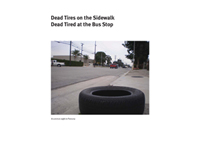
A common sight in Pomona (Photo: Andrew Kanzler)
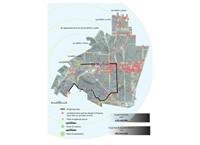
Shipping route (Photo: Andrew Kanzler)
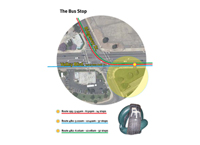
The Bus Stop (Photo: Andrew Kanzler)
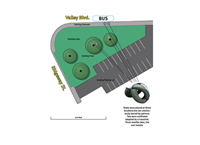
Seats were placed at these locations but are continuously moved by patrons. Two were confirmed adopted by a transient. Three months later, the rest remain. (Photo: Andrew Kanzler)
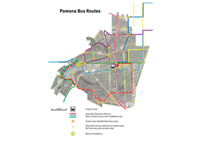
Pomona Bus Routes (Photo: Andrew Kanzler)
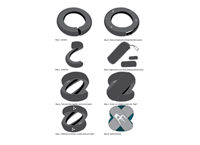
The chairs were designed to be able to hold large quantities of weight, provide ergonomic comfort, cost less than five dollars to make, and turn a waste product into a resource. (Photo: Andrew Kanzler)
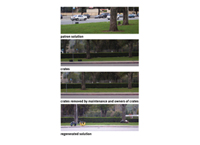
Patrons had provided their own solutions which were quickly removed by maintenance workers. A new aesthetic solution was provided. (Photo: Andrew Kanzler)
" A great guerilla solution to our ubiquitous infrastructure problem. It has a wonderful indie quality."
— 2009 Student Awards Jury
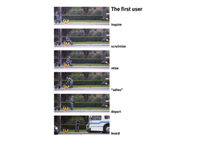
Once installed observation of the first user was recorded. His reaction to the chairs was at first confusion and curiosity. He soon chose a chair to sit in and made himself comfortable until the bus arrived. (Photo: Andrew Kanzler)
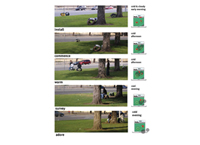
The chairs are placed by patrons in specific areas based on cold weather, typically in the sun. (Photo: Andrew Kanzler)
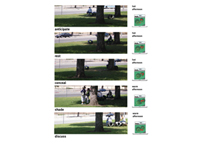
The chairs are placed by patrons in specific areas based on hot and warm weather, typically in the shade. (Photo: Andrew Kanzler)
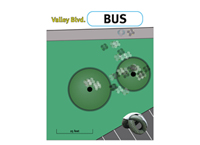
These are the documented locations of the chairs over a period of three months, recorded once a week. (Photo: Andrew Kanzler)
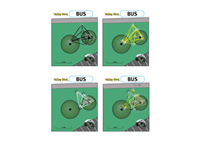
Each chair is moved within a specific triangular realm. Three points define the realm: one by each of the two trees and one close to the sidewalk. (One chair travels shorter distances likely due to its heavier weight.) (Photo: Andrew Kanzler)
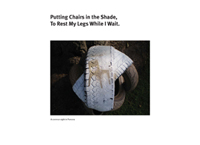
A common sight in Pomona (Photo: Andrew Kanzler)



